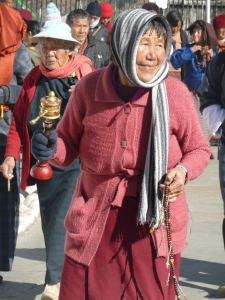Buddha is big here, obviously, super big. So big that the world’s largest Buddha statue is being constructed on a hillside over looking Thimphu.
But that is not what I mean about being big.
I mean big as imbued in people’s lives at all levels.
Officially Buddhist temples and the religious hierarchy are part of all governing life. As I mentioned earlier the administrative and theocratic are shared in the dzongs and on the national level. The monarchy is imbued and supported by both.
The famous Bhutanese Gross National Happiness indicator with its four principals–sustainable economic-social development, conservation of the environment, cultural conservation and good governance–have been likened to the Buddhist story of the four friends, the elephant, the monkey, the rabbit and the bird each stacked upon each other to get the fruit of the trees they together had previously planted and nurtured.
The GNH is underlied by Buddhist ethics according to the previous king and the goals are designed to save all beings and support meditation and Buddhist practice by all.
There are little things, like highways often have signs that just say “Thanks” for nothing in particular.
And bigger things like the banning of smoking, trying to maintain carbon neutrality and not allowing advertising.
On a community level, one notices prayer wheels, the 8 spoked wheel of dharma and other symbols everywhere. The daily life incorporation of the dharma (teachings) and not the construction of temples and shrines is the focus.
Going to shrines on certain days
and making the trek up to the Tiger’s Nest are part of this practice.
However, neither of these let’s one off the hook for daily practice.
It is in people’s behavior that one notices a certain, undescribable level of ethical behavior. Except for a squalling baby getting a cold bath that we watched, I heard no yelling or screaming in the 9 days we were here. The animals we saw, dogs, horses, cows, yaks were treated with kindness or at least absence of violence. They knew that humans even in cars would not hurt them and were either unmoved by car traffic or slowly and minimally adjusted themselves. The same held true for humans in roadways. They trusted that they would not get hit (unlike me as I walked down roads.)
I saw no road rage. The horn was used to question or warn that you were about to pass and the right blinker a sign that the way ahead was clear to pass. Bus and truck drivers drove no differently.
Seeing a truck with “Thanks” written on the back always brought a smile to me and eased the way down the road.
I don’t think people here are inherently different, they just have a religious-ethical-moral framework holding them through life. Yes, I did see kids playing with toy guns shooting pellets at the Trongsa Festival and at least once there a clown overstepped boundaries in trying to get a young woman to participate and a young monk stepped in.
I was not expecting to have this experience in Bhutan to affect my own practice. It has in all of the little and big ways. Mainly it has given me a vision of how my life in my community can be different.
Let’s see how that unfurls.
And I know the boots may be the linchpin to happiness.















